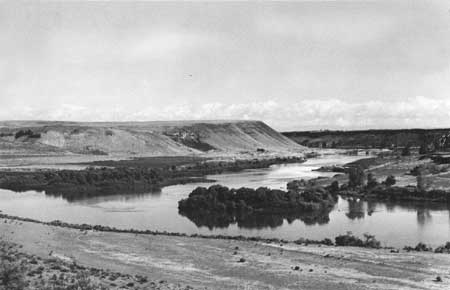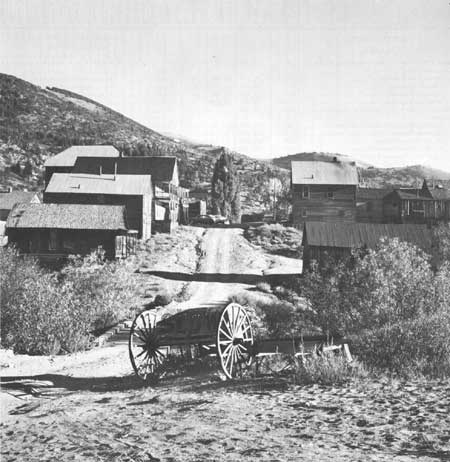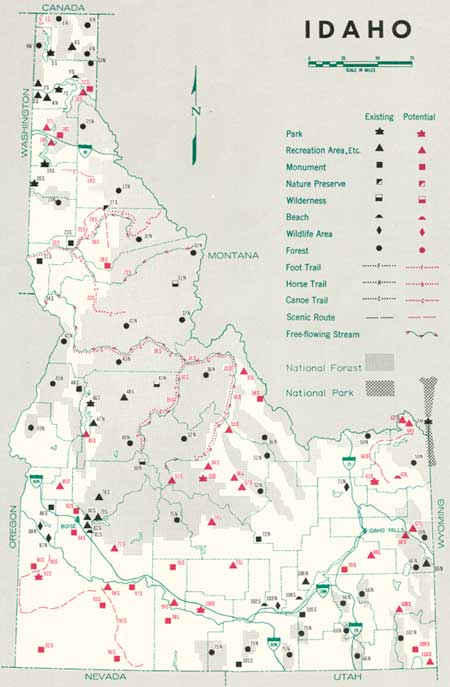.gif)
Parks for America
MENU
|
Parks for America
|

|

|
| The Thousand Springs on the Snake River, recommended as an Idaho State recreation area. |
IDAHO
IDAHO is a land of magnificent forested mountains, desert, and rivers such as the Clearwater, Salmon, and Snake. Hells Canyon rivals the Grand Canyon in depth. Over 65 percent of the State is federally owned.
The population of Idaho was 667,191 in 1960. Projections indicate 828,000 by 1976. The average density was 8 persons per square mile, varying from less than 1 in the mountainous and desert areas to 100 in parts of the Snake River Valley. About two-thirds of the people live in the Snake River Valley, where the major population centers of Boise and Pocatello are located.
Leading industries in order of importance are agriculture, lumbering, and recreation. Out-of-State tourist expenditures were $126 million in 1960 and resident recreation expenditures $75 million.
The extensive mountain ranges provide excellent opportunities for camping, hunting, sightseeing, mountaineering, and winter sports. Several thousand streams and natural lakes plus private and Federal reservoirs throughout the State offer boating, swimming, fishing, and other recreation opportunities. Good populations of big game, upland birds, and waterfowl provide excellent hunting in most parts of the State. There are over 3 million acres of designated wilderness areas, with many white-water rivers and extensive forests that offer almost unlimited opportunities for wilderness types of recreation pursuits.
Idaho is rich in Indian, fur trade, and early mining history that offers excellent opportunities for study and the establishment of historic sites.
EXISTING PUBLIC AREAS
NATIONAL: The National Park Service administers 1 national monument of 48,004 acres that had a 1960 attendance of 134,300. The portion of Yellowstone National Park located in Idaho consists of 31,488 acres. The Bureau of Sport Fisheries and Wildlife manages 47,336 acres in 4 national refuges that received an attendance of 188,448 in 1960.
There are 16 national forests with a total of 20,300,577 acres, administered by the Forest Service. Within these forests are 387 developed recreation sites occupying 4,122 acres, 16 winter sports areas with 5,029 acres, and 3 primitive areas amounting to 3,004,069 acres. The total 1960 recreation attendance for the national forests was 3,295,000. The Corps of Engineers has one reservoir area of 99,100 acres. Portions of three reservoir areas totaling 106,924 acres are administered by the Bureau of Reclamation.
STATE: Four state agencies administer recreation and related areas. The Department of Public Lands administers 25 areas totaling 25,601 acres in the State park system. The 1960 attendance at the State parks was 790,000. Under the Department of Fish and Game are 65 areas containing 43,300 acres of public and private lands purchased or leased to provide for hunting, fishing, and related activities. The Department of Highways has 130 small wayside rest and picnic areas averaging less than 1 acre each. The State forests, with 1,212,000 acres, include 23,357 acres of the State park lands.
PRIVATE ENTERPRISE: Private timber companies operate 8 recreation areas, and private power companies have 10 sites on their reservoir holdings. Outstanding winter-sports facilities have been provided at Sun Valley.
PARK AND RELATED NEEDS
The State park system needs expansion and a balanced distribution on a population and geographic basis. There is need for day and weekend use areas near urban areas in the Snake River Valley and protection of historic and archeologic sites. Additional public-use facilities are needed on natural lakes, streams, and reservoirs.
Existing State areas provide 25,601 acres, and potential State parks, recreation areas, and monuments that have been identified total 27,211 acres. Although the combined present and potential acreage may be considered adequate to meet present and 1976 needs, further consideration should be given to suitable distribution in relation to population centers. The need for local recreation areas could be met partially by the 10 areas identified. Further study is required to select suitable areas to serve local needs in the vicinity of Boise, Twin Falls, and Pocatello.

|
| The ghost town of Silver City, perched high in a mountain saddle, was once the largest of the Idaho mining camps. |
RECOMMENDATIONS
Existing recreation resources and many potential areas are shown on the accompanying tabulation and map. The following recommendations are made to help provide needed outdoor recreation opportunities for public enjoyment and use.*
*A Nez Perce National Historical Park, comprising 22 publicly and privately owned sites, has recently been proposed to preserve, commemorate and interpret the history and culture of the Nez Perce country of northern Idaho.
STATE: Enlargement of the State park system to preserve significant resources by the addition of 4 State parks, 12 recreation areas, and 4 scientific monuments, with the further study of 5 historic monuments. Five historic sites are eligible for Registered National Historic Landmark status. Designation and protection of four scenic roads, four free-flowing streams, and seven canoe trails.
LOCAL: Establishment of three recreation areas, one scientific monument, and one beach, with further study of five recreation areas.
Supporting recommendations include—
1. Strengthening of the State park administration.
2. Maintenance of minimum recreation water pools on certain reservoirs.
3. Provision for State funds to maintain and interpret historical parks.
(Table omitted from online edition)

|
| (click on image for an enlargement in a new window) |
NEXT >>>
|
|
Last Modified: Mon, Sep 6 2004 10:00:00 pm PDT
parks_america/idaho.htm
 Top
Top